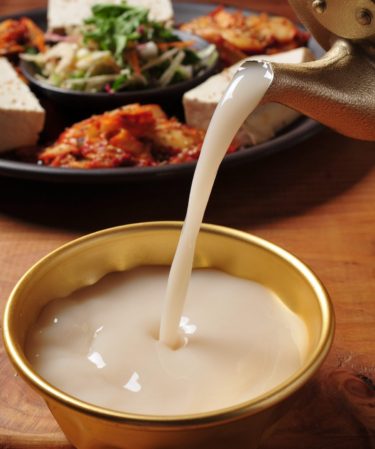The Untold Story of Makgeolli

After writing the makgeolli tasting note two months ago, I felt I still hadn’t told its full story. And it’s a compelling one, with a history, sorrow and uncertain future that almost parallel the story of Korea itself. Plus, I foresee Makgeolli becoming popular in the U.S. very soon, and you’re going to want to know a lot more about it.
First things first, makgeolli is the national drink of Korea as tequila, for example, is the national drink of Mexico. Back in the day, makgeolli was a peasant drink, considered cheap and low quality, while distilled beverages like chungju (made from A filtered base like makgeolli) and soju were for nobles. It’s only within the last decade that makgeolli’s popularity has soared among Koreans in general. No one knows for sure what triggered its resurgence, but some point to Koreans’ growing interest in traditional culture and the drink’s purported health benefits as a low-alcohol, probiotic-rich health drink.
Explaining makgeolli to non-Koreans is tricky. Despite what a lot of marketing materials claim, it is definitely NOT sake — I have heard too many people repeat this, and it seriously annoys crap out of me. But in fairness, the confusion stems from their similar production methodS: each goes through almost the same fermentation process using rice, yeast, and water, but sake production also involves filtering and resting periods, leading to higher alcohol content. Makgeolli production is simpler: it’s not filtered or aged, and it’s bottled after just a few days of fermentation. This is why makgeolli has both tons of probiotics and a very short shelf life.

Traditionally, makgeolli was considered a peasant drink because it was minimally processed and had lots of sediment, but today these characteristics are considered virtues, packed with health benefits. And while study of these benefits has only just begun, the combination of low alcohol content and high probiotics makes the drink far healthier than grape wine (which also contains anthocyanin, but not enough to have any health impact).
One area where makgeolli is entirely different from, say, French wine, German beer, or Japanese sake is its regulations. France has developed a very strict system called AOC (appellation d’origine contrôlée) that regulates French agricultural products. In Japan, sake can only be made with rice and with no other grains. For a long time, Germany had its famous Reinheitsgebot, which mandates that only water, barley, and hops may be used to make beer. By contrast, Korea has no regulations at all governing the production of makgeolli. Though makgeolli is predominantly made with rice today, until quite recently it was made with wheat, barley, and other grains. Korea’s economic transformation enabled the change: as the country emerged from colonization and war, it became, in just a few decades, wealthy and powerful.
Less than a century ago, Korea was a colony of Japan, and when Japan was forced to leave, the country was left destitute and politically unstable, leading to the Korean war in 1950-52. Throughout this history, Korea suffered from seemingly never-ending famine. It wasn’t even able to meet its demand for rice, the staple of everyday life. As a result, its use in alcohol production was banned for many decades.
All that changed quickly after the 1968 introduction of IR667, a high-yield rice variety that quickly made South Korea self sufficient. The grain was named Tongil, meaning unity in Korean. (This word has special meaning to Koreans because it is mostly used to refer to South and North Korean unification.) The Korean government had high hopes that Tongil would solve all of the country’s rice woes. And in the short term, it did. But the problem was, it was never popular with Koreans — they even said it tasted so bad that the cows wouldn’t eat it. Tongil’s failure did have an upside, however. It led researchers redouble their efforts to produce high-yield varieties that are flavorful. The new varieties succeeded, leading to steady surpluses and in 1977, the end of the ban on using rice for alcohol production. The ban’s end was such a big deal that it was one of the top five media stories of the year.

Thanks to the ban’s end, rice was quickly adopted in makgeolli production, but by this point, Koreans were too accustomed to the idea that makgeolli was low quality. Only recently has this prejudice waned. This, combined with new interest in artisanal foods, has driven new consumer interest in makgeolli.
Producers are interested, too. There is a boom in small-batch, artisanal makgeolli production and R&D by large breweries to make more delicious varieties. Makgeolli can now be found on beverage menus in high-end restaurants across Korea, which previously, and notoriously, had offered only expensive European wines. Makgeolli is even produced in the States today. There is a new, Kickstarter-funded brand called Makku based in New York, and other brands will surely follow.
I surely hope so. Makgeolli is delicious, healthy, and a perfect pairing for Korean food that seems to be getting more popular every day. For a long time, high-end Korean restaurants were too focused on creating wine menuS that paired with Korean food, and they usually didn’t work. And when you taste makgeolli yourself, remember that you heard about it from me first!
The featured image is sourced from: Atlas Obscura.